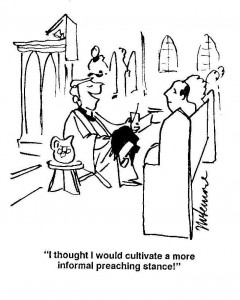Thoughts from Lori +
February 2nd is the Feast of the Presentation. (see Luke 2:22-40) It marks the occasion when Mary and Joseph, in keeping with Jewish law, brought Jesus to the Temple to be dedicated to God. As they entered the Temple, an elder named Simeon recognized the child as the Messiah. Then another elder, a woman named Anna – who the scripture says “never left the temple but worshiped there with fasting and prayer night and day” – also recognized the holy child as the “redemption of Jerusalem.” Once again, after angels and shepherds and magi, the identity of Jesus is revealed.
It is for this Anna that the Society of St. Anna the Prophet is named. The Society was founded in 2005 (see https://ssap.episcopalatlanta.org) and is recognized as a Christian Community in The Episcopal Church by the Standing Commission on Religious Communities of the House of Bishops. This is the “SSAP” you may have noticed after my name in various places such as the list of staff on our service program. I have been part of the SSAP since its inception and am a life-vowed sister. We are Episcopal lay and ordained women over 50; married, single, partnered, widowed; some retired, some working. We renew annual vows each year based on our own discernment and understanding of three principles: creativity, simplicity, and balance. Our ministries are primarily to elders and the very young.
Our annual Convocation is the weekend closest to the Feast of the Presentation. I leave for this event today, Wednesday the 28th and will return next Monday. I’m going a bit early in order to meet with our SSAP Council to discuss expansion – a chapter here in the Diocese of Chicago (about which Bishop Lee is very enthusiastic) – and staying a day longer to visit grandchildren (about which I am very enthusiastic). Bill will be here with you Sunday morning and cover any needs while I’m away. Please pray for our Society and for my safe travel.
Faithfully,
Lori +
Annual Reports
Copies of St. Paul’s Annual Report, the Rector’s 2014 Report and the 2014 Income/Expense Report are available on the table in the Narthex.
The Women’s Tea
It’s coming fast! The Women’s Tea is only one week from Sunday. See the invitation below. Tickets are on sale each Sunday, including the 8th, and in the church office (Tuesdays through Fridays from 9am to 1pm).
On Sunday afternoon at 4 o’clock on February 8, 2015
Tickets are $20 for parishioners and $10 for their guests. Proceeds will be used through Episcopal Relief and Development to benefit women in developing countries as they work to establish small businesses.
Flu Season is Here
This is likely to be one of those years when the flu season is particularly threatening. For the next few weeks, I am asking that we take precautions to protect ourselves and each other. Let’s temporarily curtain our exuberant Passing of the Peace. Instead of hugging – or even shaking hands – let’s bump elbows or simply speak the words of Christ’s Peace to each other. Yes, the elbow thing feels silly, but if it keeps us all safer, it will be worth it, and it’s only for a while. There will be safe, alcohol-based hand sanitizer in each pew. Use it as frequently as you like, but especially before coming forward for Communion. Even though it sounds counter-intuitive, please refrain from receiving Communion by Intinction. (That’s when you dip the edge of the wafer in the wine.) The silver of the chalice and the fortified wine we use reduces the spread of bacteria and viruses, and fewer are spread by sipping from the chalice than by hands hovering over the wine.
If you prefer, you may receive only the bread and be assured that you have received the sacrament. Or, if you would like me to dip the wafer for you (mine being only one hand rather than multiple hands), keep the wafer so that I can see it, and I’ll do it for you.
All of these requests are just for the time being; they are not permanent. Your patience and cooperation are much appreciated. Let’s do all we can to STAY WELL!
Coming up in February
Women’s Wednesday – Feb. 4th, 7:00 p.m. Men’s Breakfast – Saturday, Feb. 7th, 8:00 a.m. Women’s Tea – Sunday, Feb. 8th, 3 – 5 p.m. Endowment Committee – Wed., Feb. 11th, 6:30 p.m. Shrove Tuesday Tacos – Feb. 17th, 7:00 p.m. Ash Wednesday services – Feb. 18th, noon, 7:00 p.m. Vestry – Thursday, Feb. 26th, 7:00 p.m.Lessons and Hymns for Sunday, February 1st
(Fourth Sunday after Epiphany – Year B) by the Rev. William McLemoreTHE SCRIPTURE LESSONS:
The First Reading: Deuteronomy 18:15-20. God promises to send a prophet from among the people to speak for God to them.
The Psalm: Psalm 111. The wonderful works of God are praised in this psalm which begins “I will give thanks to the Lord with my whole heart.”
The Epistle: I Corinthians 8:1-13. Here, St. Paul outlines some guides for observance of dietary practices, seeking people to be sensitive to other’s needs.
The Gospel: Mark 1:21-28. This passage recounts Jesus teaching in the synagogue at Capernaum and amazing worshipers with his knowledge.
THE HYMNS:
Processional Hymn: No. 569. “God the Omnipotent.” This hymn is actually two hymns written by two different people, Henry Chorley and John Ellerton and joined together by the Society for the Propagation of Christian Knowledge (SPCK) for the Anglican Hymnal of 1871. I love the tune because of its stately movement which isn’t surprising because it is the imperial national anthem of Russia-written by Alexis Lvov at the command of Czar Nicholas I in 1933. The tune has been used in many settings, most notably the conclusion of Tchaikovsky’s “1812 Overture.”
Sequence Hymn: No. 371, “Thou Whose Almighty Word.” According to his son, this hymn based on Genesis 1:3, was written by John Marriott around 1813. It was not published during his lifetime, but was quoted six weeks after his death in a speech given to the London Missionary Society. The tune “Moscow” was composed by Felice de Giardini in the 18th century. God’s healing is mentioned in the second verse of this hymn, “Thou who didst come to bring on thy redeeming wing healing and sight, heal to the sick in mind, sight to the inly blind, now to all humankind, let there be light.”
Presentation Hymn: No. 448. “O Love How Deep, How Broad, How High.” The author of his hymn is generally believed to be Thomas a’ Kempis, born near Dusseldorf in 1379 into a peasant family. At a young age, he was sent to a pauper’s school run by a religious order in which he later became a member and was priested in 1413. The tune “Deo Gracias,” is a 15th English ballad melody and is best sung with spirit and movement.
Communion Hymn: No. 577. “Here In Christ We Gather.” This hymn was translated from the Latin original by James Dominick Quinn, S.J. (1919-2010), a Scottish Jesuit priest, theologian and hymnwriter. The words of this hymn call forth a Christian community based on love rather than discord. The tune, “Ubi Caritas,” was composed by Gregory Murray, O.S.B., (1905-1992).
Recessional Hymn: No. 493. “O For a Thousand Tongues to Sing.” This hymn was written by Charles Wesley (1707-1788), May 21, 1739, upon the first anniversary of his spiritual conversion. Wesley was ordained an Anglican priest in 1735 and came with General Oglethorpe to Georgia as his private secretary and chaplain. Because of the adverse reaction to his new environment, he returned to England. Even though tagged a “Methodist” for his support of a highly organized ministry, he refused to leave the Anglican church. He wrote over 6,500 hymns and 500 are still in common use. The fourth verse reveals the depth of his very personal conversion experience: “He speaks and listening to his voice, new life the death receive, the mournful broken hearts rejoice the humble poor believe.” The tune, ‘Azman,’ was composed by Carl Gotthilf Glaser (1784-1829).
February 1st Servants
Ushers: Terry Jaworski, Bob Backer Lector: Rick Carlstedt Intercessor: Judy Robel Eucharistic Ministers: Al Robel, Pam Dietmeyer Vestry Person of the Day: Kathy Biggerstaff101 Reasons to be an Episcopalian
Reason 30
“The Episcopal Church is a place where bishops are people too, and some of them know it. Many even have spouses to remind them.”
Linda M. Maloney, Diocese of Minnesota
From the cartoons created by the Rev. William P. McLemore
1965 – 2014


